What Auroras Look Like On Other Planets In Our Solar System
Earth's mesmerizing northern and southern lights — the auroras — have captivated humans for millennia. But our planet isn't the only world that hosts these ethereal displays. Since the 1970s, exploratory spacecraft rocketing out into the universe have revealed that auroras paint the skies of nearly every major planet in our solar system.
Each of the planets carries its own unique characteristics that result in equally distinct aurora light shows. From Mars' odd ultraviolet flashes to Jupiter's powerful polar displays, these celestial performances tell us fascinating stories about our planetary neighbors.
Scientists first gained a window into these displays in the late 1970s and early 1980s, when the Pioneer 11 spacecraft, followed by Voyager 1 and Voyager 2, discovered the presence of aurora-like light shows reminiscent of those on Earth on Jupiter, Saturn, Uranus, and Neptune. The launch of the Hubble Telescope in 1990 revealed even more about these celestial events, and today, scientists are still unraveling the mystery of auroras in the solar system.
Not all auroras are made equal
While Earth's auroras result from solar wind particles being guided to the poles by our planet's magnetic field, scientists have discovered that these light shows can emerge through different mechanisms entirely. Mars and Venus, despite lacking global magnetic fields, still experience auroral displays. Venus, a planet that has an unusual amount of moons, has an equally unusual and poorly understood phenomenon of auroras occurring on sides of the planet that face away from the Sun.
On Mars, they occur in patches above magnetic regions in its crust — remnants of the planet's ancient magnetic past. The European Mars Express mission first spotted these Martian auroras in 2005, revealing them to be very different from Earth's. Instead of being funneled by a magnetic field, solar wind particles simply crash directly into the thin Martian atmosphere.
NASA's MAVEN mission later discovered that Mars also experiences a unique type of "proton aurora" that takes place during the day. These occur when solar wind protons steal electrons from hydrogen atoms in Mars' outer atmosphere. This process actually helps scientists track how Mars is gradually losing its water to space, as the hydrogen involved comes from water molecules broken apart by sunlight. However, because both types of the planet's auroras are made of ultraviolet light, they are invisible to the human eye.
Auroras on Jupiter, Saturn, and beyond
Among all planets in the solar system, Jupiter's auroras reign supreme. Thanks to the planet's liquid, metallic core, Jupiter's auroral displays are powered by a magnetic field 16 times stronger than our own planet's, but Jupiter is unique in that it's the only planet among the gas giants to have auroras that produce x-rays.
The planet's auroras are primarily fueled by particles already trapped in its vast magnetosphere, the region around a planet in which its magnetic field exists. They're also known to fluctuate, a phenomenon that puzzled scientists for decades until 2021, when research showed that this was due to the solar wind heating up ions in the planet's magnetic field. These ions then "surf" along electromagnetic waves, triggering X-ray emissions when they strike the atmosphere. (While the solar wind travels at a million miles per hour, here's how long it would take to get to Jupiter on our fastest crewed rocket.)
In 2022, research revealed that some of the auroras on Saturn are generated by intense atmospheric winds swirling around the planet's upper atmosphere, producing the dazzlingly bright auroral displays observed by NASA's Cassini space probe in 2004. Saturn also has auroras that form from processes similar to Earth's, but like Mars, they can only be seen in ultraviolet light. Uranus and Neptune also display their own auroras, but little is known about their origin and nature, comparatively. But the auroras on Uranus prove that the lights are beautiful anywhere in the solar system, appearing as thin streaks of bright white light set against the deep azure background of the planet. Still, if you want to see the auroras up close and personal, Earth is your best bet, so make sure you know the best time to see the northern lights by season and location.


